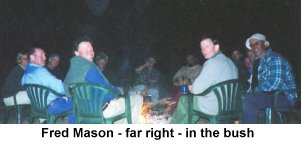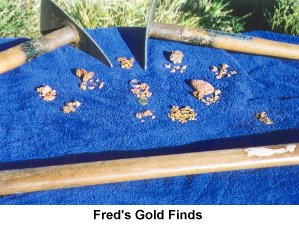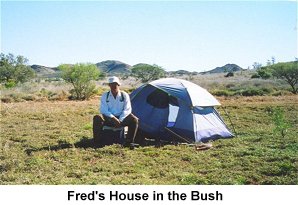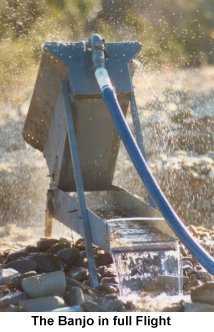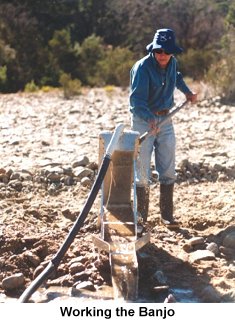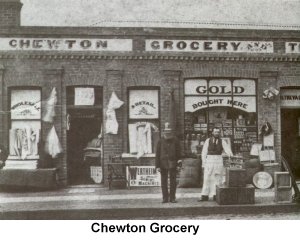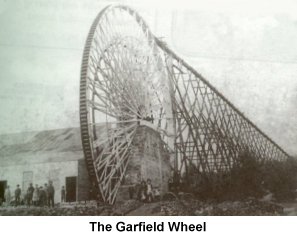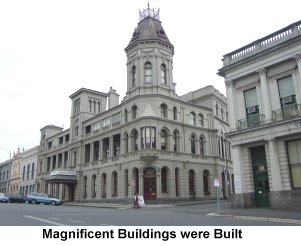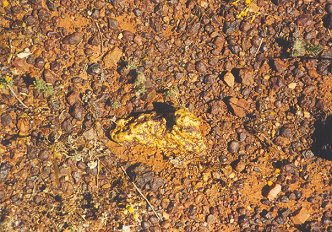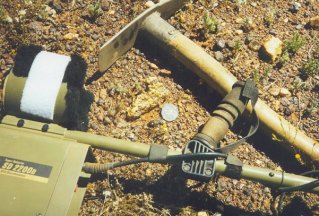
| June 2002 | ||||||||||||||||||||||||||||||||||||||||||||||||||||||||||||||||||
|
||||||||||||||||||||||||||||||||||||||||||||||||||||||||||||||||||
Contents
|
||||||||||||||||||||||||||||||||||||||||||||||||||||||||||||||||||
1. EDITORIAL From time to time we hear of nuggets being found on top of the surface. To some this is pure fiction, but although I have never found a nugget like this myself I know of some who have. Well we can now prove that this can and does happen. Recently a 42 ounce nugget was found in Western Australia half exposed. The photos in 'Strikes' speak for themselves. I just wish it was I who had walked over it. Gold Net has also been busy sourcing markets for gold bullion. A new venture for Gold Net - but never the less, dealing in gold is what we are about. A new advert details what we can do for gold bullion buyers. The price of gold certainly seems to be fluctuating. The volatile nature of global political events is certainly effecting the price. However we predict that the price will surge again shortly. The new Garrett detector has yet to be released. Speaking with Phil Stearns this week, the indications are that it should be here and available for sale within the next few weeks. This month we present a great story from a visitor from California, Fred Mason - and his experiences in Australia, while seeking gold. It presents an excellent perspective from a different point of view. We will publish stories of this type is you would like to contribute. Having previously announced that we will have a chat site soon - we advise that this is still under construction and in the near future you will see this on the site - after extensive testing. Our advertised story on Coiltek - has been deferred for the present time. This will be published in due course. Editor Email: [email protected]
All material in this magazine is copyright and may not be reproduced in any part or form whatsoever without written permission from the publisher.
|
||||||||||||||||||||||||||||||||||||||||||||||||||||||||||||||||||
2. AUSTRALIA - LAND OF MY DREAMS
 by Fred Mason I have read about Australia since I was 12 years old. The Aboriginal People, the animals and reptiles, the vast empty spaces and the GOLD have all been of endless fascination to me. I have always wanted to live there, or at least visit, but I never managed to get to Australia. Finally, in 1999, when I was 49 years old, I was encouraged by my wife to make my dream come true and so I decided I would go to Australia. Making the decision to go started a chain of actions I was completely innocent of. I had no idea the amazing number of decisions, choices and details necessary to bring about the reality of my dream. Would I go solo? Would I take an organized tour? How much money would be needed? How much equipment would I need? What would the weather be like? How would I get around? Do I need a Passport? Do I need a Visa? These were some of my logical questions.
Having selected my guide I had to wire money, something I had not done before. If you wire money be sure to arrange an immediate acknowledgement from the recipient because the bank will not take any responsibility for the funds, only the sending of the funds. I suffered several tense days waiting to know if Doug received my money or if some other person was enjoying an unintended gift! Also, realize the exchange rate is very good for U.S dollars; an Australian dollar costs about 57 cents American�so be aware of this when shopping costs for tours. Be sure to get a good supply of Au dollars and travelers checks as cash can be hard to get in the small towns of the Outback.
Your guide will give you a list of items to bring, especially bring sunscreen�it really is needed in Western Australia. I was saved from losing the cars several times because I had, and used my GPS, Australia is very different from most places I have been in the USA. Take a package of aloe based wipes�they are very useful. Limit your wardrobe to things that are useful�they won't get formal in the Outback. Spinifex-it is quite common in parts of Western Australia and is pointy and prickly grass and grows in huge patches, it is not a problem to the Aussies - they wear shorts most of the time and are pretty tough- once I adjusted to the needle-y stuff I got through it well enough. Also the critters are in and under the spinifex so watch your feet and hands. The natives will regale you with snake and spider tales, it is true lots of things will kill you there, but that is true here, in America too�be knowledgeable and cautious and you will do fine. Take a head-net large enough to fit loosely over your hat, the flies were not bad by Australian standards but I used mine and soon enough many of the others in our tour started using theirs. Learn to enjoy instant coffee; I never had a decent cup of coffee after I left the Sydney Airport. That was my greatest hardship�And by-the-way, when they start talking about "having tea" they mean lunch or dinner, I was getting worried because no one mentioned eating only "having tea" until I got a translator that explained "tea" is some sort of meal other then breakfast. So, will you find gold? If your guide guarantees gold you may want to wonder how he can make that guarantee�we had about 20 people in our group, at least one never got any gold and almost everyone had days with no gold found. I went three days in a row without a nugget and was getting a little down-in- the- mouth then I found four pieces and was happy again. I tried very hard to enjoy every thing about my trip, I wanted to really partake of the entire experience of seeing the Australian Outback; and enjoy being somewhere I might not get to see or be again.
I enjoyed all facets of my tour and will always be grateful to all the Aussies that I was with. I loved the vast empty spaces, the total lack of city noise, walking on the oldest exposed land on the planet and of course searching for the biggest nugget ever�but I didn't find it�maybe next time! My special thanks to Doug Stone and his associate Orlando; Ian and Harry, they were good to me from the start; Greg, Robin and Peter and others whose names I have misplaced; and Bob A. and his father, they told me many great stories and also gave me two beautiful boomerangs. All my gold hunting mates helped make my dream come true. If you would like to email Fred - here is the E-mail address. E-mail Fred Mason
|
||||||||||||||||||||||||||||||||||||||||||||||||||||||||||||||||||
|
||||||||||||||||||||||||||||||||||||||||||||||||||||||||||||||||||
3. THE ALLUVIAL PROSPECTOR by Jim Bowman Saturday found me rolling over in my sleeping bag opening one eye I viewed one of natures wonders, a soft mist rolling up the river just at day break with an encore from the local bird population singing to the gently rhythm of the river. Then sunrise with the reflection of the sun rays dancing over the flora making each plant appear to be dressed in a thousand jewels, as they say oh what a feeling (it's dam cold and I must get the fire going). But that was not my reason for being here Gold was my quest and this Majestic River would not let me down in that department of that I was sure. Having set the Honda 2.5 motor an p/100 pump in position the night before it was down to business and that is getting gold! But let me go back a step or two for I must explain just how I came upon this area, for you see there are a few rules you must follow if you want to find good gold sure you will get a showing from all the spots mentioned in books but so did the 200 people before you, but still try them not for the gold but to see what type of indicator is associated with the gold. Don't be like everyone else speck around before you set your equipment up. That is the first rule find what indicators go with the gold in the area that you are working.
When working fine flood gold with the Banjo it is important to get the angle on the bottom hopper right, if you don't you will lose gold. This is how I set the fall on my Banjo! Once it is in position I start my pump then put a shovel or two of sand through the machine I then watch the sand travel down the bottom hopper making sure it travels flat until it reaches the second last ripple which it then drops over and runs along a 10cm gap before passing out the end. If the sand is travelling to fast I will lift the front of the Banjo until the sand is running right. If the sand is running too slow I will lift the end of the Banjo where the rocks come out of the top hopper this manoeuvre only takes a moment or two and is not difficult to perform. 90% of the gold retained in the Banjo is placed at the top of the bottom hopper where the wash drops in from the top hopper. (Say that when you have had a beer or two - bit tricky I can tell you.) The next important rule to follow is to sample or test pan as you work. Gold leads twist and turn in any direction and the only way to keep track of them is to test pan. How dose that work you may ask well when you start working a lead count how many specks you are getting per pan, you then try panning in each direction as you work, the direction which is most consistent in gold is the line you must work. It will also tell you how deep the gold is running. The gold may only be in the top 300cm of sand or it may be one metre deep you wont know until you look. Take the time and test the area you are working it may save you digging a lot of ground that may hold very little gold if any at all! When you are working a creek you have to use a different type of method. First you must test pan across the creek bed, from where you obtain the most specks will be the lead within the creek this lead may only be a centimeter wide. If you don't go to this trouble you may walk away from the area thinking that no gold exist there at all. Where as in fact good gold did exist in that area. When you follow the two rules the amount of gold that you find will increase 10 fold if not more of that I am sure. You may need to do a trip or two just testing the area before you decide to get serious about working the area. A little more about the Banjo, If you decide to build a Banjo you must remember they will always need to be fine tuned out in the field. In regards to the angle on the top hopper it may need to be lowered or raised, the water jet's may not be just right and may need twisting one way or the other so they hit in and around the center of the top hopper. You may need to take a little off the legs to get the right fall I allow � inch to the foot in the old scale so if the bottom hopper is 3 feet long that means it may require a fall of 1 � inches overall. There are one or two people trying to copy and sell the Banjo but they don't know about the fine tuning it is a very important act that must be performed, if it is not the Banjo may only work around 50% of it's true capabilities.
I have had a lot of people say that I lose to much gold by only doing one clean out per day. But they don't understand the principle to which the Banjo operates. It is such a simple principle where gravity is the main player. The same people also had a chance to benefit from experience but let it go. If you are an alluvial prospector give the banjo serious consideration. The Banjo that I use is running at 97% retention on micro fine flood gold. In May's Online Gold Net magazine I talked on how to build a Banjo (the basic model) that style of Banjo should have a retention rate of around 89 % which is still very good on micro fine flood gold.
To do any good at this type of prospecting there are 3 points you need to follow.
|
||||||||||||||||||||||||||||||||||||||||||||||||||||||||||||||||||
|
||||||||||||||||||||||||||||||||||||||||||||||||||||||||||||||||||
4. MOUNT ALEXANDER DIGGINGS by Craig Wilson Much has been written about the "Great Gold Mountain" in the gold fields of Australia, and Mount Alexander, in the Victorian gold fields. It was indeed a great gold mountain that lived up to its name again and again. The Mount Alexander diggings cover a large area. It stretches from Castlemaine in the west through to Chewton further east - and although Mount Alexander is not high by global standards, it could be identified in Australia as a small mountain. Well it was more like a series of low hills but none the less it poured forth gold in abundant quantities, that gained it a reputation world wide as a "Gold Mountain". It was late in the year of 1851 when gold was reported here by three shepherds. The "rush" to Mount Alexander was not the immediateflood as most goldfields were at this time - but it was only a short time before the true worth of this magnificent gold field was recognised and the real flood of diggers rushed in.
At the time the area was best known as the Forest Creek diggings. Because of the incredible richness of this area, men came from all over Australia.
The colonial government in Melbourne took steps to gain revenue from this source by planning to raise the licence fee - from 30 shillings a month to 3 pounds a month. This was a 100% increase that incensed the diggers.
The strength of this protest stunned the government and plans to formally adopt the 3 pounds fee were abandoned, at this time. The variety of diggers from all corners of the world can be gleaned from the names that each area was given. Adelaide Flat, California Gull, Manchester Flat, Switzerland Reef, White Horse Gully, Dirty Dicks, Deadman's Gully, and the like. Each name had a local meaning, and was well known to those in the area - and in most cases recorded on official documents to detail specific areas.
Poverty Hill and Three Speck Gully were names used to display a not so lucky area. But Hundredweight Hill and Nuggetty Flat were obviously more productive. I leave to your own imagination, Murdering and Chokem Flat, Bung-eye Gully, and Burying Ground Flat. Geological facts now indicate that the gold from this region may have its origins as much as 400 million years ago, and as recent as 10 million years ago. This gold became concentrated in the Forest Creek river flats of today, making the diggers efforts incredibly rewarding.
One of the drawbacks on the gold fields was a lack of timber. With 30,000 diggers to keep warm, bath and for other commercial applications, the timbered flats were soon denuded of trees. Even as far back at 1855, detrimental comment was made regarding this destruction of the native flora. That debate continues to the present date.
The Garfield Waterwheel was an enormous structure, measuring 72 feet in diameter. It used water brought from the Caliban River to drive a huge crushing plant. Constructed in 1887, the wheel drove a 15 head stamper around the clock except on Sundays. The area is well worth a visit and if you are simply seeking information on gold you could easily spend a week here looking at old gold relics. The old towns in the area ooze a sense of history that is clearly displayed. Many of the locals do not recognise they are living with so much history. Mining in this area has continued unabated here for over 150 years. The Forest Creek Gold Mine continues to operate today.
|
||||||||||||||||||||||||||||||||||||||||||||||||||||||||||||||||||
|
||||||||||||||||||||||||||||||||||||||||||||||||||||||||||||||||||
|
5. WE ARE AUSTRALIA - PART 2  by Brad Williams Perhaps the most influential period in the development of Australia as a nation came during the 50 years from 1850 until 1900. Even today, with the development of faster communications and air travel, Australia is still an isolated place from both Europe and North America. In 1850 that isolation was magnified and was, to those who were living here, a serious impediment to both those administering government and those who were isolated from the rest of the world. With the discovery of gold in both New South Wales and Victoria in the early 1850's there was an explosion of humanity into the country from all over the world. It was indeed an exciting era in the history of Australia. The separate colonial Governments struggled with administering their areas of responsibility and in the worst case scenarios, some of their administrative structures collapsed. Coping with the rapidly expanding population was a nightmare for administrators, and generally those appointed did their job well. There are always exceptions of course, and one of these incompetent administrators probably caused the only civil rebellion in the history of white settlement in Australia, when the diggers stood against the oppressive licence fees at the Eureka Stockade, at Ballarat.
The massive increases in populations were difficult to control and public order was always an issue. The Bush-Ranger era during the 1850-1880's was a particularly colourful era that rivals and surpasses in most cases the Wild West era of the United States as it grew through Nationhood. At the conclusion of the golden era in Australia, once again the colonies began to struggle for the cash flows that the gold era provided. Developing industries were battling to survive, and with many of the men who had come to the gold fields returning to their home lands the population decreased substantially. This of course placed great strains on administrations and many people became unemployed as Government workers were no longer required.
The movement towards federation began prior to 1850.
In 1883 The Federal Council of Australasia was formed. This Council of colonial governments, and also including New Zealand and Pacific membership, was not supported by NSW and South Australia.
With the South African Boar War breaking out in 1899 the clear necessity to support the mother country in this conflict was evident. Although contingents from Australia were sent, this was pushed forward the long road towards nationhood.
In 1889 Sir Henry Parkes - who was at the time Premier of New South Wales declared that the time for Federation has arrived.
Legislation was put in place by the colonies to move the process forward, and subsequently negotiations in Great Britain led to the British Parliament passing legislation that allowed Australia to become a nation. This legislation was assented to by Queen Victoria in 1900.
On January 26th 1901, Lord Hopetoun, the first Governor General of Australia proclaims the Commonwealth of Australia at a ceremony in Sydney.
What brought the nation together as a people not long after this event was the beginning of World War 1. With Brittain being at war - Australia was at war. Australian troops landed at what became known as ANZAC Cove on the Iberian Peninsula in Turkey. Fighting was extremely bitter and casualties horrific. Although they fought with distinction, the military task was impossible. Facing withering machine gun fire and an enemy determined to protect his homeland the tradition of mateship courage and determination was born. Although the troops were eventually withdrawn the ANZAC tradition and what these men suffered and endured is today and always has been highly respected throughout this nation.
Australia recently buried the last surviving ANZAC, Private Alec Campbell.
|
||||||||||||||||||||||||||||||||||||||||||||||||||||||||||||||||||
|
||||||||||||||||||||||||||||||||||||||||||||||||||||||||||||||||||
6. THE DEATH OF LICOLA - PART 3 by Ralph Barraclough At no stage did any person from Parks/DNRE visit Kevin's property to see if they had survived, or needed help. As Kevin and his helpers searched for burnt animals to destroy, hordes of people from Parks/ DN'RE stood around idle, for hours on end, day after day, near his boundary fence.
Three days after the fire went through, without any warning, the sky crane (Elvis) came to Kevin's creek, to collect water. His animals were terrified of this and as the fences were burnt, made off into the National Park. The first contact Kevin had with Parks Victoria was on Sat Jan 17. The second was the following day. He had his rifle (legally registered) - used for putting down injured and dying stock - confiscated by Rangers. He was in their Park. Kevin was told to take his dogs home. He was faced with the impossible task of trying to muster scattered cattle in the mountains without dogs. He was prosecuted for stock outside his fence. A track near Bryces Gorge where he makes over 20% of his income from was closed off to horses. Signs were just put up with no consultation or warning. CATTLE GRAZING
Parks Victoria started to use this disaster, of their own creation, as an excuse to push agendas to frustrate groups they disliked as early as Jan. 4.
Plots were fenced off around rocky outcrops, dead limbs, fallen bark and places where grass never grew in the first place, then monitored to see how they would grow. Bench marks were set from vegetation surveys on Bogong, a granite monolith, with loose soils and applied to vegetation on soils derived from rhyolite and shales at a considerably lower altitude on Bennison. Grazing was banned for the first season after the fire by a group of three (two were from Parks). One had already said on ABC radio that grazing would not go ahead, this was before both sides of the argument were in. Another was a recent arrival to Australia who denied there was a problem flowing from the Park (like the 50,000 tonnes of mud). This same fellow expressed a worry that cattle might cause erosion problems.
When the grazing dispute went to an "independent" disputes panel, Minister Garbutt tried to have a former president of the National Parks Association on the panel. The closure of a 140 year old historical stock route, that lead from Licola to Bennison, was stopped by local people (none were cattlemen) blockading the park until it was reopened. CONFUSION REIGNS A respected and well organised motorbike rally that had been held with strong local support for years in the park near Licola, was told after the fire that all roads were closed along the Wellington River. When this was challenged by local people, the organisers were told the Wellington was unfit for human consumption. This was found to be untrue, it caused serious concern to the local people trying to truck water from the Wellington, as Licola had no other water supply.
The rally went ahead, but the following year Parks banned the "Confusion Rally" blaming them for not using toilets, littering, impacts to the soil, illegal as well as large campfires with excessive use of fire wood. Statutory declarations from local people subsequently described the carnpsite in the park before most of the bikes arrived, "as being heavily littered and like walking through a minefield of human excrement." WEED AND DINGO PROBLEMS
To compliment the demise of the cattle and much of the timber industry, the park is now producing a different kind of produce. Blackberries and cape broom are completely out of control and choke large areas of Wonnangatta. The Dargo area is now at risk of broom spreading down the river. There have been so many dingos coming out of the park that all bar one farm here have had to stop running sheep to control weeds. A t Dargo, St. Johns wort is so bad that cattle are falling in the river and drowning after eating it. As things stand, it is just a matter of time before areas around Licola are similarly effected. The Government is trying to implement a weeds and dingo strategy that brings the problems back to the land holders, with only the margins of Parks & DNRE land as part of the plan. There has been little or no spraying this year of St. John's wort around campsites in the park along the Wellington River, or road reserves. One of the reasons given to exclude cattle after the fire was they might cause the spread of dandelion, sorrel and white clover in the National Park.
|
||||||||||||||||||||||||||||||||||||||||||||||||||||||||||||||||||
|
||||||||||||||||||||||||||||||||||||||||||||||||||||||||||||||||||
7. FLECKS ! - Glints from here and there
|
||||||||||||||||||||||||||||||||||||||||||||||||||||||||||||||||||
|
Listed below are the restrictions that the Victorian government is imposing on rural communities.
|
||||||||||||||||||||||||||||||||||||||||||||||||||||||||||||||||||
|
||||||||||||||||||||||||||||||||||||||||||||||||||||||||||||||||||
|
||||||||||||||||||||||||||||||||||||||||||||||||||||||||||||||||||
8. STRIKES Recent Finds
|
||||||||||||||||||||||||||||||||||||||||||||||||||||||||||||||||||
|
||||||||||||||||||||||||||||||||||||||||||||||||||||||||||||||||||
|
9. THE NEW LODE - Next Month's Issue
|
||||||||||||||||||||||||||||||||||||||||||||||||||||||||||||||||||
|
||||||||||||||||||||||||||||||||||||||||||||||||||||||||||||||||||
